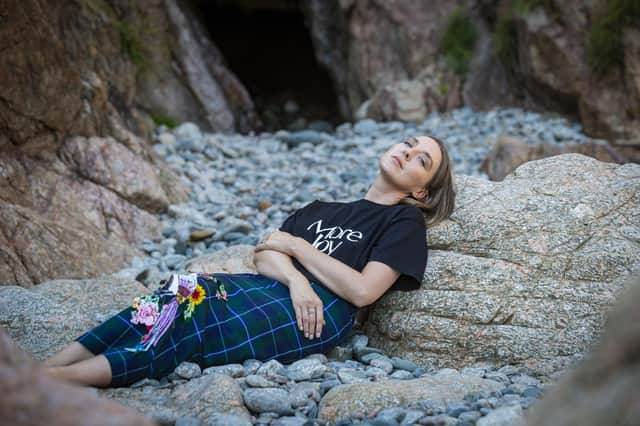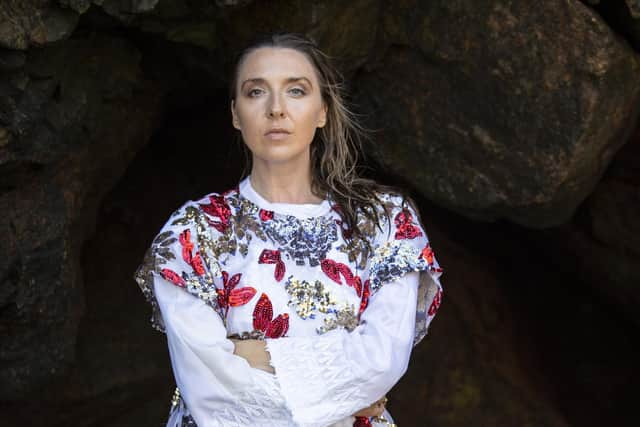Fashion: How Scotland Dressed the World - Lynne Coleman


In How Scotland Dressed the World, Lynne Coleman explores the country’s rich cultural impact on the modern world. Telling the tales of the cloth that covers continents and how it has woven itself into political and economic movements. No matter what style tribe you subscribe to this book shows how it all starts in Scotland. From ‘gallus’ and ‘peely-wally’, to Ralph Lauren’s ‘preppy chic’. Whoever you are, however you dress, you will always have a piece of Scotland with you - even if it’s only in your wellies.
Trends. You’ve heard of them, probably bought into some and certainly scoffed at several; but, there’s a dirty little secret this stylist wants to share. The secret is that Scotland is the home of trendsetting around the globe.
Advertisement
Hide AdAdvertisement
Hide AdFor over a decade, I’ve worked with brands such as Burberry and Mulberry. I’ve had my breath taken away, sitting cheek by jowl at Chanel’s Métiers d’Art show and I’ve pulled my pick of the high street on a weekly basis for newspapers and fashion magazines. This was all done in tandem with working across the textiles sector here in Scotland, as Brand Guardian of our oldest artisan tartan mill – DC Dalgliesh – and amassing the largest personal library of tartan on the planet, each swatch sourced from all the weaving mills in our homeland. So, as you can see, my research credentials are pretty rock solid.


Between publications, runways and a plethora of press dinners in every fashion capital, one thing became abundantly clear: Scotland’s impact on style around the world is so huge that I began seeing a pattern in trends that would lead me straight back to our bonnie, bonnie banks.
Our fabric is the storyteller of fashion, the yarn-spinner of clothing. We go to war in the stuff and marry in it – how wonderful to wander around in this walking contradiction of a cloth.
From the rebellion of 1745 to the dismantling of the movement a year later that resulted in our national dress being banned, leading to its regal reinstating by George IV two hundred years ago; my new book marks the centenary of a movement that cemented Scotland’s style credentials.
These fibres are soaked in gasoline levels of storytelling, so flammable it has ignited the hearts and imaginations of the masses around the world. The beauty of it all is that you don’t have to be Scottish to aspire to its aesthetic.


From preppy to punk, romance to royalty, gothic to grunge, I’ll be taking you through the trends that are intrenched in Scottish style that we see storming runways every season.
Like the story that links Kurt Cobain with Dennis the Menace and got Marc Jacobs fired.
Now our link back to Scotland via Seattle doesn’t come from Cobain being born in Aberdeen, or even attending Aberdeen High School. That’s Aberdeen, Washington, and not the oil rich shores of the ’shire. This story is grungier than that.
Advertisement
Hide AdAdvertisement
Hide AdIn the summer of 1992, Nirvana played at the King’s Hall in Belfast. That night, a local lad called Chris Black from Whitehead went to the gig wearing a black and red Dennis the Menace jumper. Courtney Love clocked it and began bartering to buy it. She loved it and wanted to gift it to Kurt. Reluctantly, Chris parted with the sweater for £35, selling it to a jubilant Love. The tale has been retold in newspapers and radio programmes ever since.
From there, the musician was pictured in Dennis the Menace’s pullover a plethora of times.
The symbolism of Cobain cocooned inside Dennis’s attire is not lost on me. What that character represents – a lost little boy adored by the world but who impacts his loved ones on a daily basis with naughty self-indulgent behaviour – is a poetic microcosm. I have no idea if Love knew the Dennis the Menace backstory when she bought it, but this piece of parabolic paraphernalia certainly has more weight added to it knowing that she chose it.
By the time winter rolled round that year, a young Marc Jacobs sent a collection down the runway that critics scoffed at. Why? you may ask. Well, he’d been brought into Perry Ellis fresh out of Parsons to inject some youthful ideas into their stuttering sportswear line. Things weren’t really running to plan. The final nail in his coffin came when he sent Naomi Campbell and Kate Moss down the catwalk in Cobain-inspired clobber. Looking at it today, the collection was utter genius. Bias-cut tartan skirts teamed with cute cartoon t-shirts and finished with loose shirts and knitted beanies; it looked like Scotland-the-chic, but fashion writers condemned it. They stated that he’d raided Seattle’s thrift stores and hardcore grunge lovers hurtled hatred at him, accusing him of selling out their beloved movement.
Fast forward to the present day and there isn’t a fashionista worth her salt who doesn’t know Marc’s name. His impact on popular culture has been firmly felt for three decades. And what of that infamous wee jumper? Well, Jacobs has brought out different variations of The Grunge Sweater by Marc Jacobs over the years. In 2018, he marked the 25th anniversary of the dreaded Perry Ellis collection by recapturing the vibe. It would prove another controversial move, with the surviving members of Nirvana suing Jacobs for a reimagined version of their smiley face Nevermind logo, resulting in a countersuit from Team Jacobs. Someone should remind them if anyone should be hacked-off for style stealing it’s our poor wee Dundonian Dennis.
Now let’s talk romance. Interestingly, people come to me asking which tartan their surname belongs to. The answer is never simple since there are thousands of tartan variations under any given name. Even more beautiful, there’s a tradition of creating brand new tartans when two families come together. That’s one of the reasons you find so many differing patterns sharing the same surname. I may be showing my soppy side here, but I think that’s ludicrously romantic. Through working with the mill, I have seen first-hand the enormous presence Scotland has on the global wedding market. We have shipped wedding kilts to over 120 countries around the globe and we are just one of several Scottish tartan mills, which blows my mind.
Much has been written about Gabrielle Chanel’s love affair with Scotland and our fabrics. In the Highlands, her hideaway home – Rosehall Estate – unlovingly crumbling, which I think is a national disgrace. She personally hand painted the wallpaper, for Christ’s sake. It makes me want to weep!
Despite this during its heyday, Rosehall was loved. It provided the perfect amount of remoteness for Gabrielle to play out her romance with the Duke of Westminster, who resided there with her during their affair in the 1920s. Winston Churchill recuperated on the estate around 1928 and letters about his stay have since been published.
Advertisement
Hide AdAdvertisement
Hide AdAccording to the National Records of Scotland, Churchill passed comment on Chanel to his wife in one letter: ‘She fishes from morning ’til night, and in two months has killed 50 salmon.’
The importance of this estate on Coco’s inspiration and subsequent brand-building is not to be overlooked. This home formed the backbone of the woman she wanted to evolve into. The lady of the manor is quintessential Chanel. Tweeds and cashmeres fit to entertain in, (but still have an air of ease about them should you wish to fish) are really just polished ensembles of hunting gear around here. This is how Parisian Preppy was born.
It’s a relationship that still thrives today, with Chanel owning Barrie Knitwear in the Scottish Borders.
From Paris to Hollywood…
Sailing on True Love, Grace Kelly and Bing Crosby serenade one another. It’s a scene mid-movie from High Society that I never tire of watching. Kelly is wearing a powder pink cashmere twinset, beautifully belted in the middle and worn with a full skirt in a similar shade. Behind Bing sits a tartan blanket waiting patiently to be used whenever the moment should arise. But it never does. Obviously, the cashmere twinset was at the peak of its popularity in the 1950s, so you might want to argue that it would have been an obvious choice to have it involved in her costume design for this role.
That being said, there is a strong relationship at play here between our leading lady and one of Scotland’s biggest textile giants. Kelly was a colossal cashmere fan. More than that, she was a loyal Pringle of Scotland customer too. It is said that she would celebrate momentous moments in her life by buying a twinset from the brand whenever she wanted to commemorate something. Usually, flying into their flagship store in New York to do so.
Several years ago, Central Saint Martins and Pringle of Scotland collaborated on a beautiful project celebrating their muse. Students from the school were allowed access to the princess’s personal cashmere archive and designed a capsule that would eventually go on sale. The jumpers were incredible.
This American mid-century prep-fest is the modern-day snapshot to how our Atlantic cousins consume their preppy. It’s certainly the cornerstone of Ralph Lauren, and to me, the essence of their vibe. From Liv Tyler and Renée Zellweger in their tiny tartan kilts and fuzzy midriff knits in Empire Records to Cher and Dionne wearing their co-ord plaid blazers and skirts in Clueless, American preppy has a sugariness that we don’t see in our European counterparts.
Back in old Blighty, preppy takes on a melting pot of vibes. You can, quite rightly, go straight to Sloane Ranger ideals, but there is a collision in the culture that makes our North/South divide bind. This harps back to the aesthetic that Coco Chanel clung onto while in the Highlands. It’s clothing for the countryside. In modern-day Britain, it's best viewed via the lens of a festival. Think muddy fields, unpredictable weather and clobber that has to look chic but be practical. It’s Alexa Chung, from Glastonbury to T in the Park. Beige and khaki waxed jackets and welly boots paired with the hint of a sharp collar under a funky knit. Chung is my quintessential British preppy muse.
Advertisement
Hide AdAdvertisement
Hide AdWith all this waterproofing, it should be no surprise for you to discover that waxed raincoats started life in Scotland. Charles Macintosh made the Mac out of rubberised fabric. They first went on sale in 1824. Charles patented the idea after Scottish surgeon James Syme conducted a chemical experiment leading him to discover a valuable substance could be obtainable from coal tar, which has the property of dissolving India rubber and could be used for waterproofing silk and other textile fabrics. The Macintosh headquarters are still in Cumbernauld to this day. Synonymous with Humphrey Bogart, it’s hard not to think of him standing in a trilby, dressed in a Mac, when conjuring thoughts of the overcoats. Thank God it rains so much in Scotland, without it we could have missed out on one of the world’s most iconic cinematic moments and it’s all thanks to that coat.
How Scotland Dressed the World, by Lynne Coleman, by Luath Press, is published next month
Comments
Want to join the conversation? Please or to comment on this article.